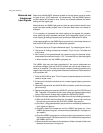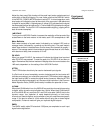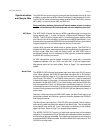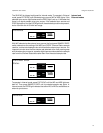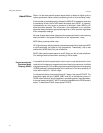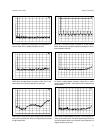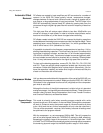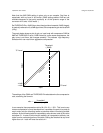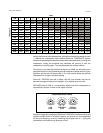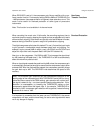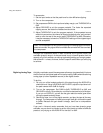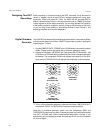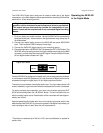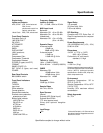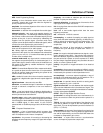
Definition of Terms
29
20/20 AD User Guide
Definition of Terms
AES : Audio Engineering Society.
aliasing : a form of distortion which occurs when an A/D
converter’s sample rate is less than twice the highest fre-
quency component of a signal.
amplitude : the maximum departure of the value of a wave-
form from its average value.
attenuation : a reduction in the amplitude of an audio signal.
balanced signals : two equal and opposite signals run
through a twisted pair. The advantage of balanced signals is
that common mode noise tends to be added equally to both
portions of the pair; it can be removed by subtracting the
negative from the positive signal. (Common mode noise
rejection cannot be performed on unbalanced signals, which
consist of an audio signal and a ground return.)
bandwidth : the arithmetic difference between the upper and
lower cut-off frequencies of an audio system.
bit : binary digit: the smallest unit of digital information,
equivalent to the result of a choice between two alternatives
(
yes
or
no
,
on
or
off
, 0
or
1
). A series of bits make up a binary
number called a
sample word
.
common mode noise :any signal which is common to both
the negative and positive polarity of a balanced signal. In a
typical audio signal, common mode noise is introduced over
the length of the cable by outside interference. A typical
example is line hum.
CMRR : Common Mode Rejection Ratio: measures the ability
of a system to reject common mode noise. It is expressed as
the ratio of common mode noise entering the system to the
common mode noise leaving it.
dBfs : decibel full scale: this is the unit used to describe the
amplitude of a digital audio signal where 0 equals digital full
scale.
digital headroom : does not exist, see dBfs.
distortion : an unwanted change in a waveform as it passes
through an electronic component or from one medium to
another.
dither : a low level signal which is added to digital audio to
reduce quantization noise, in effect, by replacing it with noise
which is perceived as less offensive.
dynamic range : when used to describe digital-to-analog or
analog-to-digital converters, dynamic range is the ratio of the
full scale signal to the broadband noise (0-20 kHz) measured
with a -60dBfs signal. In other words, it is the S/(N+D)
measured with a -60 dBfs input signal and a 20 kHz low-pass
filter.
EBU : European Broadcast Union.
emphasis : a form of equalization which increases high
frequency signals in order to maximize the signal-to-noise
ratio. De-emphasis is the inverse of emphasis.
equalization : the process of increasing or decreasing the
amplitude of some frequency ranges of a signal with respect
to others.
frequency : the number of vibrations per unit of time, ex-
pressed in cycles per second (Hz).
harmonic distortion : the appearance of harmonics of the
input signal at the output of a device.
link : the tying of two channels of the 20/20 AD compressor to
a shared gain curve.
lock : two or more audio signals which have the same
frequency and phase.
mS : millisecond: 1/1000 of a second.
oversampling : a method of sampling an audio signal at
many times the audio bandwidth (typically, 64-256 times) in
order to reduce the complexity of the anti-aliasing filter. The
oversampled data is then digitally filtered to reduce the
sample rate.
period : the interval of time required for a waveform to
complete one cycle and begin to repeat itself. Period = 1/
frequency.
phase : the angular relationship between two signals, meas-
ured in degrees, where 360° = the period of the waveform.
When two identical signals are always of the same polarity,
they are said to be
in phase
, or to have a phase of 0°. When
they are always of opposite polarity, they are said to be
out of
phase
, or to have a phase of 180°.
polarity : the positive or negative direction of an electrical
force.
quantization : the process of converting an infinitely-varying
waveform into a finite series of discrete levels. The inaccuracy
introduced by this process is called quantization error.
rms amplitude : root mean squared amplitude: a way of
assigning a DC power equivalent to an AC waveform. For a
sine wave, this is 0.707 times the peak level.
sample rate : the periodic interval at which an analog audio
signal is sampled, e.g. 44.1 or 48 kHz.
signal-to-noise ratio : the ratio between the maximum peak
signal and the wideband noise in the absence of signal. This
number becomes more meaningful when distortion is added.
It is then expressed as S/(N+D).
S/PDIF : Sony/Phillips Digital Interface Format.
synchronize : to arrange events to occur simultaneously. In
audio, the events are both the period and the phase of a
signal.
THD+N : the ratio of the rms amplitude of the distortion and
noise that is added to a signal to the rms amplitude of the
signal itself. This can be expressed in percent or decibels. S/
(N+D) = 1/(THD+N).
time constant : the amount of time it takes for a signal to rise
or fall 63% of its full scale. This only pertains to signals which
rise and fall exponentially, such as the 20/20 AD meter time
constants or compression gain curves.
word clock : a square wave used as a synchronization
source. Its frequency equals the sample rate.



